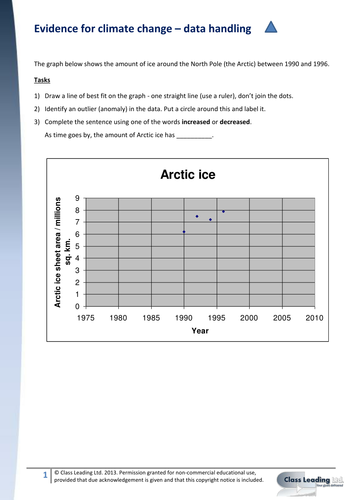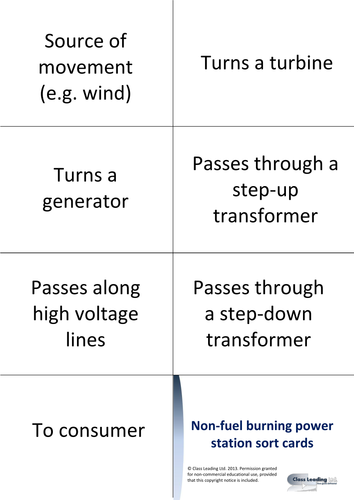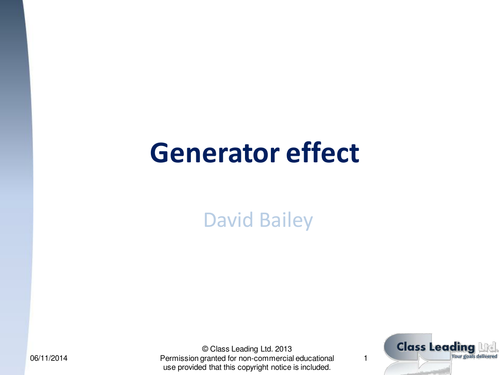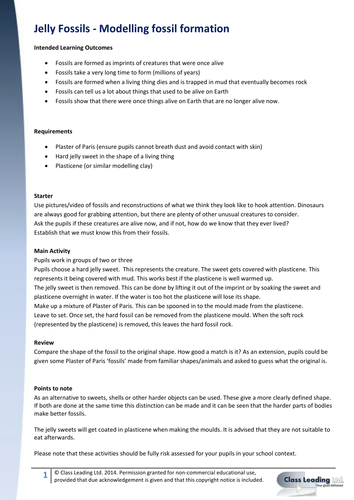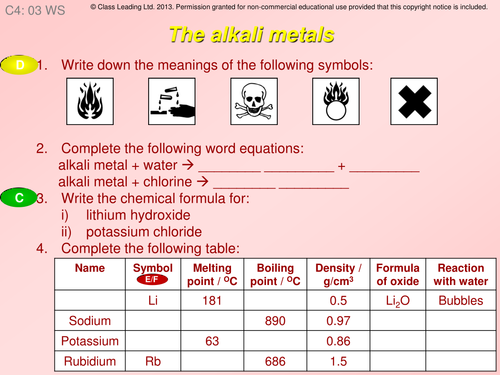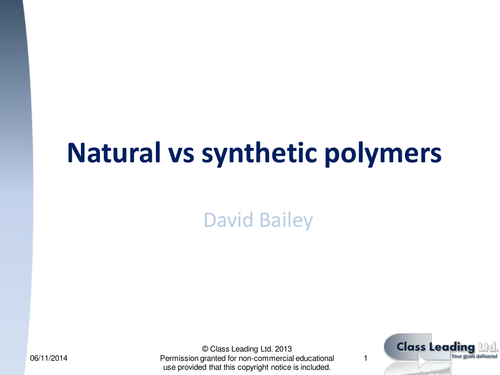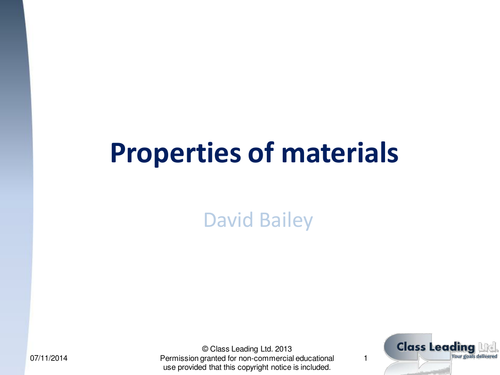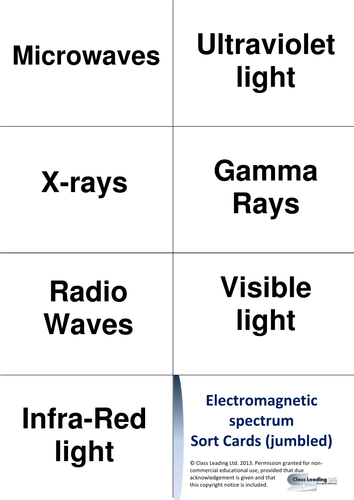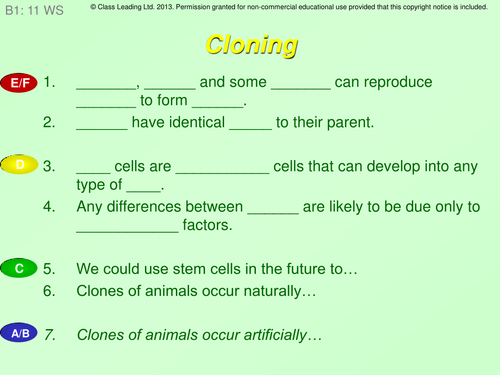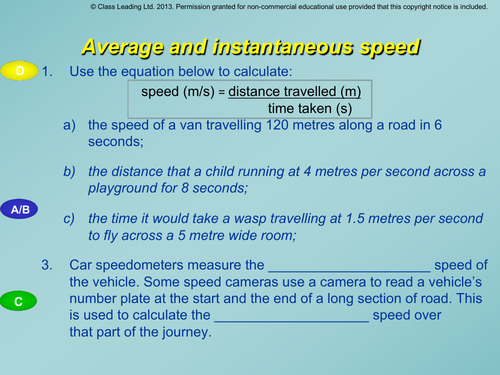314Uploads
260k+Views
194k+Downloads
All resources

Evidence for climate change - data handling
This is a short standalone activity, good for developing higher order thinking skills and providing an opportunity for cognitive conflict and discussion. Firstly either allow the students to work through the first two set of tasks sequentially. Alternatively, one half of class can be given first sheet,marked with a triangle, the other half being given the ones marked with a square to be worked on independently. After a few mins pair up with third sheet. Students respond well to even quite tricky questions.

Phases of the moon
In this activity, pupils are at the centre of model that shows how the Moon orbits the Earth and how this leads to the phases of the moon appearing. A description of how to do this is shown. A worksheet for recording the appearance of the moon model is included, with answers.
There are also links to a NASA video showing the phases of the moon, the first 30 seconds of which could be used to hook learners. A second video showing the experiment is also linked.
Please ensure that you have carried out a full risk assessment before carrying out any practical activity.

Tweet Sheets - Summarising learning
This resource consists of three sheets, each of which is made up of 6 squares that can be cut out and given to learners. They can be used by learners to summarise their learning. This is ideal for the review phase (plenary) of a lesson or before the lesson with a flipped learning (classroom) approach.
There is a plain sheet and also versions to support neater writing by learners using an idea from dyslexia expert Neil Mackay. The highlighed version s help learners form neater letters in a similar way that half-way lined paper does. A grey version is included for B/W photocopying.

Power station sort cards - sequencing
This resource is to help learners either learn or revise the sequence of events in generating electricity for consumers. The statements on the card are partial statements about what happens during this sequence. Learners could try sorting these as a prediction of the sequence. This allows for discussion & cognitive conflict. Students could justify their reasoning, complete the statements and/or sequence by indicating what is being referred to at each stage, compare similarities é differences é highlight differences in other power stations e.g. nuclear. Jumbled é non-jumbled versions included.

Car efficiency - Data handling
Keywords: Efficiency, calculation, graph, skill, explain, justify, MAT.
This activity is designed to stretch the most able learners with some questions and tasks related to calculating efficiency. There are some demanding questions involving handling data and using graphs to make predictions. This was designed as a home learning task to consolidate learning about efficiency.
It would also make a suitable starter for AS/A level.
An answer sheet is included with suggested marks for each question.

Generator effect - graded questions
This activity contains a powerpoint with graded questions & answers and matching pupil activity sheets, designed to be used at the end of a lesson and/or the start of the next lesson to review previous learning. The questions are based on the previous OCR 21st Century Science Specification unit P5, although could be used with other exam boards.
Clicking through the show reveals answers one a time. These reduce to A5 easily, the ideal size for most pupils. Please note grades are approximate.

Engaging 'hats' model of electric circuits
Keywords: circuit, model, current, charge, electron, hats
This is an engaging model for students to participate in modelling electric circuits. It is aimed at KS3, but has been used successfully with KS4 and KS5. It helps students build a coherent model to explain circuits, although alternative models help explain energy transfers and potential difference (voltage) better.
Please note that this was originally published a number of years ago as part of the North Yorkshire Success for All project.
A premium PowerPoint slideshow that provides a visual model of the motion of charges in the circuit is also available at https://www.tes.com/teaching-resource/resource-12613884

Polymerisation - graded questions
This activity contains a powerpoint with graded questions & answers and matching pupil activity sheets, designed to be used at the end of a lesson and/or the start of the next lesson to review previous learning. The questions are based on the previous OCR 21st Century Science Specification unit C2, although could be used with other exam boards.
Clicking through the show reveals answers one a time. These reduce to A5 easily, the ideal size for most pupils. Please note grades are approximate.

Jelly fossils - Modelling
In this activity, pupils go through the process of making a fossil of a jelly sweet to show how fossilisation takes place. A description of how to do this is included in the guide. Please ensure that you have carried out a full risk assessment before carrying out any practical activity.

Alkali metals - graded questions
This activity contains a powerpoint with graded questions & answers and matching pupil activity sheets, designed to be used at the end of a lesson and/or the start of the next lesson to review previous learning. The questions are based on the previous OCR 21st Century Science Specification unit C4, although could be used with other exam boards.
Clicking through the show reveals answers one a time. These reduce to A5 easily, the ideal size for most pupils. Please note grades are approximate.

Life cycle analysis - graded questions
This activity contains a powerpoint with graded questions & answers and matching pupil activity sheets, designed to be used at the end of a lesson and/or the start of the next lesson to review previous learning. The questions are based on the previous OCR 21st Century Science Specification unit C2, although could be used with other exam boards.
Clicking through the show reveals answers one a time. These reduce to A5 easily, the ideal size for most pupils. Please note grades are approximate.

Ohm's Law - graded questions
This activity contains a powerpoint with graded questions & answers and matching pupil activity sheets, designed to be used at the end of a lesson and/or the start of the next lesson to review previous learning. The questions are based on the previous OCR 21st Century Science Specification unit P5, although could be used with other exam boards.
Clicking through the show reveals answers one a time. These reduce to A5 easily, the ideal size for most pupils. Please note grades are approximate.

Natural vs synthetic polymers - graded questions
This activity contains a powerpoint with graded questions & answers and matching pupil activity sheets, designed to be used at the end of a lesson and/or the start of the next lesson to review previous learning. The questions are based on the previous OCR 21st Century Science Specification unit C2, although could be used with other exam boards.
Clicking through the show reveals answers one a time. These reduce to A5 easily, the ideal size for most pupils. Please note grades are approximate.

Properties of materials - graded questions
This activity contains a powerpoint with graded questions & answers and matching pupil activity sheets, designed to be used at the end of a lesson and/or the start of the next lesson to review previous learning. The questions are based on the previous OCR 21st Century Science Specification unit C2, although could be used with other exam boards.
Clicking through the show reveals answers one a time. These reduce to A5 easily, the ideal size for most pupils. Please note grades are approximate.

Electromagnetic (EM) Spectrum sort cards
These sort cards can be used as a starter or starting point for the topic of the EM spectrum and again as a review/ plenary. They can also be used to help revise the sequence of the EM spectrum. This activity goes well with the EM grid activity.
This resource is part of a sequence with the following three other resources:
This resource
EM spectrum sort cards https://www.tes.com/teaching-resource/resource-6341302
IR remote control https://www.tes.com/teaching-resource/resource-12952897
UV Washing powder https://www.tes.com/teaching-resource/resource-12952892

Cloning - graded questions
This activity contains a powerpoint with graded questions & answers and matching pupil activity sheets, designed to be used at the end of a lesson and/or the start of the next lesson to review previous learning. The questions are based on the previous OCR 21st Century Science Specification unit B1, although could be used with other exam boards.
Clicking through the show reveals answers one a time. These reduce to A5 easily, the ideal size for most pupils. Please note grades are approximate.

Average & Instantaneous speed - graded questions
This activity contains a powerpoint with graded questions & answers and matching pupil activity sheets, designed to be used at the end of a lesson and/or the start of the next lesson to review previous learning. The questions are based on the previous OCR 21st Century Science Specification unit P4, although could be used with other exam boards.
Clicking through the show reveals answers one a time. These reduce to A5 easily, the ideal size for most pupils. Please note grades are approximate.

Nuclear power - graded questions
This activity contains a powerpoint with graded questions & answers and matching pupil activity sheets, designed to be used at the end of a lesson and/or the start of the next lesson to review previous learning. The questions are based on the previous OCR 21st Century Science Specification unit P3, although could be used with other exam boards.
Clicking through the show reveals answers one a time. These reduce to A5 easily, the ideal size for most pupils. Please note grades are approximate.
The error pointed out in this has been corrected - thanks for spotting!

Particles - Standard Model Flashcards
These flashcards, when printed out back-to-back and then cut out will produce a series of double sided flashcards showing the composition of particles in the standard model. They are good as an independent learning tool or revision activity. They could be used in preparation for the 'Identify the particle rolling slideshow Instant Engagement / Retrieval - available on TES Resources at:
https://www.tes.com/teaching-resource/resource-6341196

Active modelling - String vs mobile phone
Keywords: digital, analogue, encode, decode.
Notes: This activity helps learners compare how a simple string telephone works against a more complex digital system. Get the students to make string telephones using paper/plastic cups and lengths of string before attempting to complete the sheet. This helps explain an abstract idea by building up from a very hands on simple (more concrete) example. It really engages learners of all abilities. There is an activity sheet and a guidance sheet with answers. This was originally designed for OCR 21st Century Science unit P2

